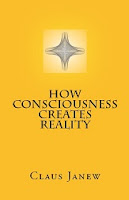The question of whether we can freely choose among
several possibilities, without imagining this freedom or confusing it with
chance, leads us to the truth about our responsibility. For if we had to answer
for something that came from us but was not decided
by us, it would be no more than the responsibility of a cloud for its rain.
To find the answer, let us consider the simple choice between two continuations of our day, for example, whether to go to the cinema or to the theater. Actually, we like both equally, although sometimes we feel more like one than the other. Today, however, we really don't care; we could just as well flip a coin. But we don't - that would be too cheap. We think. We put ourselves into the cinema, then into the theater, then back into the present, and so on. In this way we circumscribe the entirety of the decision situation, the present being its center. Strictly speaking, this center is infinitely small, right in the middle of the whole circumscription with all its details. That is, in us.
In the periphery, in turn, our perception of the
cinema influences the subsequent perception of the theater, and vice versa -
and again, our present, and vice versa. The indeterminacy
between the determined alternatives
thus condenses into the determinacy
of the decision situation right up to its exact center, which, on the other
hand, is completely neutral, i.e. behaves indeterminately.
But that makes the whole situation indeterminate again, and so on.
We are not finished yet: Cinema and theater inside and
outside, as well as the ways to get there with all the details, are also
circumscribed by the movement of our attention. Instead of letting our thoughts
circle around a cinema, we might as well wander to the subway and the dance
club and forget about the whole theater. Instead, we consciously focus on the
trade-offs between destinations, seats, access routes. That is, the
determinacy/indeterminacy structure applies to
every detail of the trade-off process. And so small decisions are due
everywhere. We cannot escape this decision structure anywhere - it is an
i-structure (infinitesimality structure).
This process structure unites determinacy and indeterminacy at every place, even completely. Since both refer to each other and merge into each other toward the center of the thus circumscribed totality, they are no longer even partially separated there.
So where is the respective "point" of
decision? Obviously not in the neutral center between the alternatives, but between center and periphery, in that
very center between determinacy and indeterminacy. Wherever that is. Because
"that" can always only be in-between,
otherwise it would be a side. One can only "limit" it, but never fix
it. In fact, it is distributed throughout the whole process and is only concentrated in central places - altogether in us, but in the direction
of our goals and between them.
Out of this i-structured unity of subunits not only
can, but must, come a free decision. This is the only possibility, the only
meaningful description. It does not matter that to outsiders the choice could
also have been predominantly random or conditional. Coincidences and conditions
such as weather and schedules naturally entered into the decision and limited
its scope in the peripheral area of the process. But the periphery is only one
side of the whole - one of the non-decisive sides.
Alternating Consciousness. From Perception to Infinities and Back to Free Will

